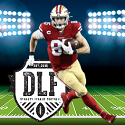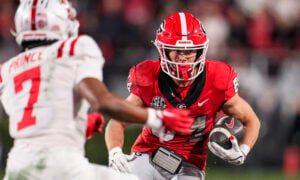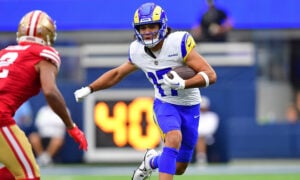Late-Round Rookie Running Backs
The 2020 NFL Draft might be remembered as one of the deepest draft classes at wide receiver. With that being said, it’s possible that some late-round running backs are being overlooked. Are there any worth giving attention to, and if so, which ones should merit your attention when your third or fourth-round selection is on the clock?
Below is a quick dive into each rookie running back beyond the top eight that I’ve already researched here and here. I’ve scouted each RB individually pre-draft and — now that each back has found a new team — I’m ready to declare some to be worth selecting with your late picks.
Darrynton Evans, RB TEN
Evans is a one-cut runner best suited for the style of offense that the Titans happen to employ. His 5’10” 203-pound frame is nearly ideal for most NFL teams. He has great speed and displayed enough talent at the Scouting Combine necessary to be a starter.
Some knocks on Evans are that he doesn’t always play with his hips pointed downfield, and several times I observed him leaning into his cuts rather than using proper technique to avoid defenders. This may work well at the college level, especially in the Sun Belt Conference where Evans played, but it will not work in the NFL.
Most of his highlight plays are more a display of elite speed than elusiveness or making room at the line of scrimmage. He has just enough power to play with the big guys but may need to add weight to his frame in order to take the beating an NFL season requires.
Overall, I believe Evans to be a project pick for the Titans. He will not be a threat to Derrick Henry for the 2020 season, who signed his one-year franchise tender on April 2. However, I believe the grooming of Evans will give the Titans a backup plan if they don’t end up signing Henry to a long-term deal.
Darrynton Evans is worth a late selection, especially to the Henry owners. Time will tell if he has the ability to be a lead back in the NFL. If you draft him, the plan would be to expect to sit him on your bench the entire season and wait until free agency next year. If Henry re-signs with Tennessee, Evans will be a long-term handcuff. If Henry walks, Evans could be the future at RB for the Titans.
Joshua Kelley, RB LAC
This might be my favorite late-round selection in the rookie draft. Kelley is in the range of prototypical size at 5’11”, 212 pounds. He ran a 4.49-second 40-yard dash at the combine, and though his measurables for explosiveness and leg strength garnered mixed results, his tests for agility and change of direction were off the charts. Kelley ran a 6.95-second three-cone drill — best among all rookie running backs.
His interviews are outstanding. He’s intelligent and mature, far more advanced than his peers when it comes to knowledge of the game and what it takes to be a professional. Kelley has also worked hard on his skills and it shows on film.
He doesn’t have quite the talent as the top backs, but his hard work is evidenced by the several times I saw him use proper stutter-steps and jump cuts. He was able to create space at times and outran defenders when there was an open field.
Overall, I think Kelley is a quality late pick. He doesn’t have the same talent as the high-end backs, but what he lacks in talent he makes up for in skill. I do not expect Kelley to ever be top 15 at his position, but he will fit nicely in the RBBC role that the Chargers employ, and become a quality flex play for years to come.
Lamical Perine, RB NYJ
He is a confusing player to analyze. Perine has great tape, but he followed that up with a subpar combine performance. It’s possible that Perine could be one of those backs who needs to be in a game setting to be effective.
You can tell he worked hard in practice – displayed by the proper skills found on his game film – but he lacks a bit at every athletic attribute. I find Perine to be an excellent pick if you’re the Le’Veon Bell owner, but I wouldn’t hold out much hope for anything else.
Anthony McFarland, RB PIT
McFarland has excellent speed but not much else. He performed poorly at the combine in the vertical and broad jumps, exercises that measure explosiveness and leg strength, which is necessary for a back like McFarland.
He has a lengthy injury history, and I believe the responses he gave during combine interviews display a lack of depth of game knowledge and positional understanding. I question how reliable he would be in a classroom setting. McFarland is not on my draft radar.
DeeJay Dallas, RB SEA
While the tape looks good, the combine numbers for Dallas didn’t match. This is almost always a red flag when analyzing a player. On top of this, he suffered an arm injury as a junior which probably scared him into declaring for the draft too early.
The good news for Dallas is that he was drafted into a system that can best utilize his strengths. He’s a power runner first, and that’s going to fit well in the system employed in Seattle. Though he lacks talent, evidenced by his subpar combine numbers, he has decent skills to make up for it.
Dallas could be a surprise starter at some point down the road for Seattle, who has a history of taking late-round or undrafted running backs and turning them into starters. I don’t believe he will ever be a long-term solution, and should only be drafted to be flipped for a second-round pick later on — should the time ever arise to do so.
Jason Huntley, RB DET
I believe Huntley was many people’s darling entering the draft because of his amazing pro day numbers, but I came away with a different take after watching his game film.
Though he has excellent speed and quick feet, I found that he doesn’t lower his hips enough and didn’t seem to work too hard to develop any real skills at the collegiate level.
He’s a little undersized, and his competition was the subpar talent he faced at New Mexico State. I think Huntley is better suited as a returner than running back, and will most likely be an RBBC back than anything else in his professional career. He’s worth taking if your league values total yards, but a hard pass everywhere else.
Eno Benjamin, RB ARI
Benjamin isn’t terribly fast, as displayed when he posted a 4.57 40 at the combine, but his tape shows quick feet and strong legs. Though his lower body is fantastic, his upper body is lean and could use work. Benjamin only managed 12 reps at 225 pounds on the bench press, well below the target score of 22 for a running back.
One thing that jumped out at me is a strong character and sense of self-worth he displayed in his interviews. While this may not be a sentiment shared by all, I find his decision to launch a clothing line with his own face and name to be self-centered and somewhat off-putting. This could also be one reason why he fell all the way to the seventh round of the NFL draft.
I don’t love the selection but he could be a wise one for any Kenyan Drake owner out there. I’m not a believer in the other backs on the team, so Benjamin could very well sneak his way into the number two spot and share some work with Drake during the season. I wouldn’t spend more than a fourth-round pick on him.
Raymond Calais, RB TB
Calais is an under-sized speed demon. He has fast feet and used many quick moves and head fakes to juke defenders, but at 5’8” and 177 pounds, he’s not the kind of back that will ever be elite at the NFL level. He might become a pass-catcher out of the backfield, but Tampa Bay has never utilized such a position before, and I doubt that will start now. He’s a hard pass.
- 2023 Dynasty Riser, Faller and Longshot Predictions: San Francisco 49ers - July 28, 2023
- The Dynasty Value of Trading a 2023 Rookie Pick for a 2024 Pick - May 19, 2023
- How and Where to Pick Running Backs - May 15, 2023


































































